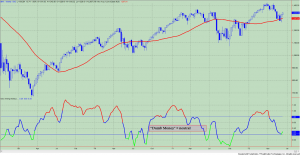by Guy Lerner, Technical Take
Last week’s bullish signal in the “dumb money” indicator has come and gone just like that – poof! I guess sentiment isn’t really too bearish. Yet, can you blame investors for being less bearish since it is all but certain that some central bank will be intervening on the slightest drop in the equity markets. As least that is what investors seem to believe. Despite investor’s certainty in a certain outcome, the lack of consensus in the sentiment data would suggest that the whatever bounce emanates it should not be very sustainable. Corporate insiders have been net sellers, and the Rydex data is more consistent with a market top than a market bottom. As I have argued there is no consensus.
The market finds itself at another one of those junctures that have been prevalent over the past 3 years. The market signals are bearish for prices or let’s be generous and say less supportive of a big rally. Yet, the only requirement for a big rally will be central bank intervention. We saw this back in August, 201o with QE2 and in August, 2011 with Operation Twist (i.e., QE3). The main difference in 2012 is the expectation and anticipation of the markets. Like Pavlov’s dog, everyone seems to be all over the next round of QE. Investors have learned quickly that the markets go up when central bankers open their mouths. I always believe that the central bankers are NOT in the business of disappointing the markets, so my expectation is that they will do whatever takes. However, I am less convinced that the markets will respond in a manner that will meet investors’ expectations. Whatever rally unfolds is likely to end just like that – poof!
The “Dumb Money” indicator (see figure 1) looks for extremes in the data from 4 different groups of investors who historically have been wrong on the market: 1) Investors Intelligence; 2) MarketVane; 3) American Association of Individual Investors; and 4) the put call ratio. This indicator is neutral.
Figure 1. “Dumb Money”/ weekly

Figure 2 is a weekly chart of the SP500 with the InsiderScore “entire market” value in the lower panel. From the InsiderScore weekly report: “Market-wide sentiment moved to its worst level since the week ended May 8th as the number of buyers fell -41% week-over-week and the number of sellers increased 23% over the same period. Many of our top-line sentiment tracking metrics moved into negative territory, slipping below their 52-week averages in the process. The decline in buying was widespread, touching all market cap classes and most sectors, with especially significant reductions in buying activity in Energy, Financials and Healthcare. On a company-level basis, there continued to be a fairly high level of actionable buys, however, the incidences of actionable selling also picked up. We should soon begin to see a seasonal decline in transactional activity as companies close trading windows for insiders ahead of the end of the quarter, with the windows remaining closed until after Q2’12 earnings announcements.”
Figure 2. InsiderScore “Entire Market” value/ weekly

Figure 3 is a weekly chart of the SP500. The indicator in the lower panel measures all the assets in the Rydex bullish oriented equity funds divided by the sum of assets in the bullish oriented equity funds plus the assets in the bearish oriented equity funds. When the indicator is green, the value is low and there is fear in the market; this is where market bottoms are forged. When the indicator is red, there is complacency in the market. There are too many bulls and this is when market advances stall. Currently, the value of the indicator is 61.66%. Values less than 50% are associated with market bottoms. Values greater than 58% are associated with market tops. It should be noted that the market topped out in 2011 with this indicator between 70% and 71%.
Figure 3. Rydex Total Bull v. Total Bear/ weekly

Copyright © Technical Take












